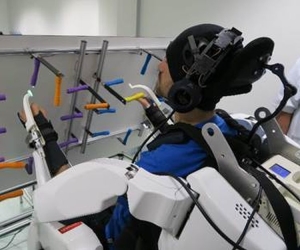 For the first time, a tetraplegic patient was able to walk and control both arms using this neuroprosthetic, which records, transmits, and decodes brain signals in real-time to control an exoskeleton. The results of a clinical study under the Brain Computer Interface (BCI) Project at Clinatec were published on 4 October 2019 in The Lancet Neurology journal and provide proof of concept for controlling a four-limb exoskeleton. The system is driven via the long-term implant of a semi-invasive medical device to record brain activity developed at CEA in Grenoble. In the long term, this technology is expected to give greater mobility to individuals with severe motor disabilities.
For the first time, a tetraplegic patient was able to walk and control both arms using this neuroprosthetic, which records, transmits, and decodes brain signals in real-time to control an exoskeleton. The results of a clinical study under the Brain Computer Interface (BCI) Project at Clinatec were published on 4 October 2019 in The Lancet Neurology journal and provide proof of concept for controlling a four-limb exoskeleton. The system is driven via the long-term implant of a semi-invasive medical device to record brain activity developed at CEA in Grenoble. In the long term, this technology is expected to give greater mobility to individuals with severe motor disabilities.
Tetraplegia is caused by a lesion on the spinal cord that prevents the nervous system from controlling all four limbs. To limit dependency and facilitate the mobility of patients with this severe disability, medical doctors, physicians and researchers at Clinatec, the CEA laboratory in Grenoble operated with the Grenoble university hospital, have developed a device to control a four-limb exoskeleton that records and decodes brain signals.
The major innovation in this device is its ability to provide chronic high-resolution recording of the brain’s electrical activity. This activity related to the moving intention is transmitted it in real-time wirelessly to a computer for decoding in order to control the movements of the exoskeleton’s four limbs.
Alim-Louis Benabid, neurosurgeon, Professor Emeritus at Université Grenoble Alpes, lead author of the publication in The Lancet Neurology journal, and Chair of the Board at Clinatec, worked with a team to design the implantable device (WIMAGINE®) that collects brain signals in the sensorimotor cortex emitted when an individual imagines moving. The tetraplegic patient can move by mentally controlling the exoskeleton: external controls are unnecessary. According to Professor Benabid, “This device is an important step forward in helping people with disabilities become self-sufficient. We are extremely proud of this proof of concept and are already considering new applications to make everyday life easier for people with severe motor disabilities.”
With the authorisation of regulatory authorities, Clinatec is conducting a clinical trial to test the device on a 28-year-old tetraplegic patient with a lesion on his spinal cord. The results were published on 3 October 2019 in The Lancet Neurology journal. Two WIMAGINE® devices were implanted in June 2017 on the right and left sides of the upper sensorimotor area of the brain, above the patient’s dura mater. The operation at Clinatec was performed by Professor Stephan Chabardes, co-author of the publication, a neurosurgeon at CHU Grenoble Alpes, and Medical Director at Clinatec. “Contributing to the success of this project by providing medical care to the patient was an incredible experience,” Dr. Chabardes explains.
Since the operation, the patient has spent 27 months performing various types of exercises to practice controlling the exoskeleton. He practices in virtual environments with the exoskeleton avatar at home three times a week and works directly with the exoskeleton at Clinatec one week every month. When fitted with the suspended exoskeleton, he is able to take several successive steps and control his two upper limbs in three dimensions. He also can rotate his wrists while sitting or standing.
This patient will continue his involvement in this research protocol at Clinatec and will actively participate in future developments. This proof of concept for a neuroprosthetic providing this level of freedom will open the door to new applications for use at home by patients in their everyday lives. The Clinatec team is working on integrating new effectors, such as a wheelchair, and developing even robust and more precise algorithms to perform more complex movements, with the hope of later enabling tasks such as holding an object. Three other tetraplegic patients will also be included in this clinical trial in the coming years.

